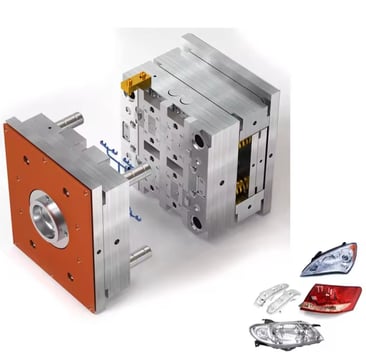The Mold Manufacturing Process: A Comprehensive Overview
Mold manufacturing is a critical process in the production of various components across multiple industries, including automotive, consumer goods, and healthcare. Understanding the mold manufacturing process is essential for businesses looking to optimize production efficiency, reduce costs, and improve product quality. In this article, we will explore the key stages of mold manufacturing, from design to production, highlighting best practices and considerations at each step.
9/18/20243 min read


# The Mold Manufacturing Process: A Comprehensive Overview
## Introduction
Mold manufacturing is a critical process in the production of various components across multiple industries, including automotive, consumer goods, and healthcare. Understanding the mold manufacturing process is essential for businesses looking to optimize production efficiency, reduce costs, and improve product quality. In this article, we will explore the key stages of mold manufacturing, from design to production, highlighting best practices and considerations at each step.
## 1. Design Phase
### 1.1 Concept Development
The mold manufacturing process begins with the development of a concept based on customer specifications and requirements. This stage involves collaboration between engineers, designers, and clients to determine the shape, size, and functionality of the part to be produced.
### 1.2 CAD Modeling
Once the concept is established, the next step is to create a detailed 3D model using Computer-Aided Design (CAD) software. This model serves as the blueprint for the mold and allows for precise visualization of the part's geometry.
### 1.3 Design for Manufacturability (DFM)
During the design phase, it's crucial to consider manufacturability. DFM principles ensure that the mold can be produced efficiently and effectively. Key factors include:
- Material Selection: Choosing the right materials for both the mold and the final product.
- Part Geometry: Designing parts with appropriate features for easy mold release and minimal material waste.
- Assembly Considerations: Ensuring that the mold components fit together seamlessly.
## 2. Mold Construction
### 2.1 Material Preparation
Once the design is finalized, the next step is preparing the materials. Common materials used for molds include:
- Steel: Known for its durability and strength, ideal for high-volume production.
- Aluminum: Lightweight and easier to machine, suitable for low to medium production runs.
- Special Alloys: For specific applications requiring unique properties.
### 2.2 Machining
Machining involves cutting and shaping the material to create the mold components. This process can include various techniques:
- CNC Milling: Computer-controlled milling machines are used to achieve precise shapes and tolerances.
- EDM (Electrical Discharge Machining): This technique uses electrical discharges to create complex geometries that are difficult to achieve through traditional machining.
### 2.3 Assembly
After machining, the mold components are assembled. This stage requires precision to ensure that all parts fit together correctly. Key considerations include:
- Alignment: Proper alignment of mold halves to ensure consistent part quality.
- Cooling Systems: Integrating cooling channels to regulate temperature during production, improving cycle times and product quality.
## 3. Testing and Validation
### 3.1 Mold Trials
Before full-scale production, the mold undergoes a series of trials to test its performance. This phase involves:
- Initial Runs: Producing sample parts to identify any issues in the mold design or operation.
- Adjustments: Making necessary modifications based on trial results, such as adjusting cooling systems or refining mold features.
### 3.2 Quality Control
Quality control is essential during the testing phase. Manufacturers use various inspection methods, such as:
- Dimensional Measurement: Ensuring that produced parts meet specified tolerances.
- Visual Inspection: Checking for surface defects or inconsistencies in the finished product.
## 4. Production Phase
### 4.1 Mass Production
Once the mold passes all tests, it is ready for mass production. The production process involves:
- Material Loading: Feeding raw materials into the injection or blow molding machines.
- Molding Cycle: The cycle time varies based on the complexity of the part and the type of mold used.
### 4.2 Quality Assurance
During mass production, continuous quality assurance is vital. This includes:
- Regular Inspections: Conducting inspections at various stages of production to ensure consistent quality.
- Process Monitoring: Using sensors and monitoring systems to track machine performance and detect any anomalies.
## 5. Maintenance and Rework
### 5.1 Mold Maintenance
Regular maintenance is essential to extend the lifespan of molds and ensure consistent production quality. Key maintenance activities include:
- Cleaning: Regular cleaning to prevent buildup of residues and contaminants.
- Inspection: Routine inspections to identify wear and tear, allowing for timely repairs.
### 5.2 Rework and Refurbishment
If a mold shows signs of degradation or wear, rework or refurbishment may be necessary. This process can include:
- Repairing Damaged Areas: Using welding or machining to restore mold functionality.
- Updating Design Features: Making modifications to adapt to new production requirements or technologies.
## Conclusion
The mold manufacturing process is a multifaceted operation that requires careful planning, precision engineering, and rigorous quality control. By understanding each stage of the process, businesses can enhance their production efficiency, reduce costs, and ensure high-quality products. As the industry continues to evolve, embracing new technologies and best practices will be crucial for staying competitive.
---
This overview provides a detailed look at the mold manufacturing process, covering each step from design to production. If you need further elaboration on specific topics or additional insights, feel free to ask!
